Suffer acute mountain sickness in Tibet in 2010 - Part 1/2
(Travel Story Series @ Hon Too Fang 2021)
In 2010, I joined a 14-day tour to Tibet in China. We landed in Lhasa and went further west. This is my reflection on the tour. Not an amusing travel account. Tibet is too harsh in living conditions to make joke of and the Tibetans too holy to be made fun of.
1 - Tibet the region
The Tibet Autonomous Region 西藏自治区has an area of 1.28 million sq km or nearly 4 times the size of Malaysia. The population is about 3 million, making the region the least populated in density in China. About 90% are ethnic Tibetans and 8% Han. Tibet is located in the Tibetan Plateau, the highest region on Earth, with an average elevation of 4,380 m.
In terms of history the first Tibetan kingdom emerged in the 3rd century BC. In Chinese history this region was called Tubo 吐蕃. In the mid-7th century, the 33rd king Songsten Gampo expanded the empire, moved the capital to Lhasa. At its peak the Tibetan Empire covered part of present day India and Nepal, several provinces of modern China and part of Afghanistan to the west. It declined after 2 centuries.
When the Mongols conquered central China and established the Yuan Dynasty in the 13th century, Tibet came under the Yuan rule. When the Ming Dynasty replaced the Yuan, Tibet started to function more like an independent region. But during the next Qing Dynasty at the middle of the 17th century, Tibetan was again included in the Chinese territory, with Qing army stationed in the region. When the Republic of China was established in 1912 and in subsequent years of internet unrest due to revolting powerful warlords, Japanese invasion and later the war between the Communist and the Kuomintang, Tibet again claimed de facto independence though the claim was not recognised by any of the federal governments. In 1952, the army of the People’s Republic of China came into Tibet to exert control.
The economy of Tibet is traditionally dominated by subsistence agriculture. One peculiar cash crop is the harvesting of the fungus cordyceps sinensis 冬虫夏草 which contributes some 3 to 4 % of the GDP and 30-40% of cash in the rural areas. The price of this fungus, considered a powerful herbal medicine has sky-rocketed in recent years.
But tourism is picking up fast after the completion of the Qingzang Railway in 2006. And with it the sale of handicraft items. It received about 6 million visitors in 2009, contributing 15% to the GDP. The growth rate for the economy in the past decade is more than 10% per year.
(Note in 2021: Tourist arrival in 2019 is expect to be near to 30 million, an increase of 5 times in 10 years, contributing 25% of the GDP)
2 - Tibetan Buddhism and the Pilgrims
Before embracing Buddhism, the Tibetans followed Bonism, a semi-animist religion. Tibetan Buddhism has thus incorporated elements of Bonism into the facets of worship, like prayer flags, prayer wheels, and pilgrimage. There are 4 main schools, the most dominant one is the Gulag (Yellow Hat) follow by the Sakya (Red Hat). At any of the temple sites pilgrims would walk and encircle the holy place, praying their beads or turning the prayer wheels.
Shown pilgrims turning prayer wheels at the Sera Monastery 色拉寺, near Lhasa and colourful prayer flags dotting the rural landscape. The prayer flags are not plain fabric but fabric printed with images, mantras and sutras, often using woodblock-printing technique.
The most striking feature is pilgrims prostrating themselves on the ground to pray. They first stand upright, do a half squat, lunge their body forwards with the hands touching the ground and the whole body flat on the ground. Most do so with their hands and body padded for the impact, or the ground is padded with blankets. But I have also seen pilgrims just slide their bare hands on the ground, dirt or grass. There might be a technique not to injure themselves.
Shown pilgrims prostrating at Jokhang Temple in Lhasa, their most sacred temple.
They either repeat the ritual on the same spot, or walk and prostrate on the road encircling the sacred sites. It is not uncommon that pilgrims walk this way from their home villages to have their pilgrimage at the Jokhang Temple in Lhasa, taking months or even years.
Om Mani Padme Hum…... Om Mani Padme Hum……. Om Mani Padme Hum…….
This is real pilgrimage, my friends. So please don’t complain your 3 days at Mecca are too hot to bear, or how your knees hurt so badly when you kneel for 30 seconds at each of the 14 Stations of the Cross along Via Dolorosa in Old Jerusalem, or that the road to Lumbini in Nepal is infested with too many mosquitoes!
Some may comment that too much time is wasted in this kind of religious activities. Oh, my friends, so you don’t think “chasing” a 65-episode Hong Kong soup opera on TV is not wasting time? Or that following this email is not wasting time?
Some places visited
3 - What to see in Lhasa?
Everybody knows Lhasa 拉萨, meaning “Place of the Gods”, capital of the Tibet Autonomous Region, with a population of 200,000. The elevation is 3,650 m. The main tourist attractions are the Potala Palace, the Summer Palace and the Jokhang Temple, all 3 combining to form a UNESCO World Heritage site. Shown typical street scenes around our hotel, which is near to Jokhang Temple in the older part of the city. The 3rd photo shows a newer part of the city.
3.1 - Potala Palace
The Potala Palace 布达拉宫 is a fortress and the residence of the Dalai Lamas from 1649 to 1959. Since 1959 it has become a museum. Construction was started by the 5th Dalai Lama in 1645. Overall it took about 45 years. The Dalai Lama is a monk of the Gelug sect believed to be a certain reincarnated bodhisattva and considered the theocratic leader of Tibetan Buddhism. The current Dalai Lama who is in exile since 1959 is the 14th.
The fortress is 400 m by 350 m, with the sloping wall averaging 3 m thick, and 6 m thick at the base. It is 13 storey high, soaring 117 m from an elevation of 3,670 m, with over 1,000 rooms, and 10,000 shrines. The central part of the building is called the Red Palace because of the crimson colour. It houses the most important halls and shrines of the palace. The 4th photo shows the White Palace, which is the oldest part of the complex. Shown a group photo at the base of the fortress.
No photography is allowed inside any of the buildings. There was a monk following the group to ensure that the rule is not broken. Another monk was the tour guide. So no photo of the interior from me. The 2 below are taken from the internet. Photo credit: both chinadiscovery.com
Outside the palace proper is an area with a long row of prayer wheels and several typical Tibetan style images painted along the walls.
3.2 - Jokhang Temple
The Jokhang Temple 大昭寺, first built in 652 and last renovated in 1610, belongs to the Gelug sect, but followers of other sects are allowed to pray here. This is the most sacred temple in Tibet. During the Cultural Revolution in the 1960s, parts of the temple was vandalised and it was repaired in the late 1970s.
The main buildings are 4-storey, part-timber part masonry, surrounded by many buildings of lower height. The architecture is a combination of Chinese, Tibetan and Nepalese styles. Most parts of the roof are gilded. The 1st photo shows part of the Barkhor Square where it is located, with the temple buildings in the background. The 2nd photo shows the main entrance. The 5th photo shows one of the 4 giant stone incense burners in the square.
The temple interior is a dark labyrinth of chapels, illuminated by votive candles and filled with incense. There are over 3,000 Buddha images. The most precious is the Jowo Sakyamuni, a 1.5 m tall bronze status gifted by the Chinese Tang Emperor and bought over by Princess Wencheng in the 7th century. Wenchang was one of the wives of the powerful king, Songsten Gampo. No photography was allowed inside the temple.
(Note in 2021: in 2010 no photography was allowed inside the interior. But now we could find plenty of photos on the internet. May be the no-photo policy has been repealed in later years, or may be these were taken with permission. I picked 2 photos from the internet to show the interior. Photo credits: travelchina.org.cn and icefestivalharbin.com)
At the back of the temple is a structure with many prayer wheels to allow the pilgrims to turn them, 1st 2 photos. Pilgrims would also walk around the temple complex counting their beads or turning the small hand-held prayer wheels. A round takes about 20 minutes.
3.3 - Summer Palace
The Summer Palace or Norbulingka 罗布林卡 is a park and summer palace for the Dalai Lamas, located 3 km west of Potala. It was built about 100 years after the Potala Palace. Most of it was completed during the time of the 13th and 14th Dalai Lamas. It covers an area of 3.6 sq km, mostly fields and forests, and buildings with over 375 rooms.
In the Tibetan language “norbulingka” means “treasure garden”. Shown the park scenes and 2 entrance gates.
The palace consists of several clusters of buildings in typical Chinese-Tibetan style: with Han Chinese architecture and Tibetan decoration. The most luxurious is the Takten Mighur Potrang 达旦明久颇章built in 1956 by the 14th Dalai Lama, the 1st 2 photos. The oldest building is the Kelsang Potrang 格桑颇章built by the 7th Dalai Lama dated to 1751, 3rd photo, showing only part of the roof line. There is a cluster of several pavilion-style buildings built on islands in a lake. They are called Tsokyil Potrang 措吉颇章. Shown one, last photo.
And lastly showing some beautiful door decorations.
4 - What else to see in Tibet besides Lhasa?
Our tour in fact went further west, some 600 km, passing the historic towns of Gyantse and Shigatse, and ended at the outpost of Tingri, which is near to the Nepali border, to view the peak of Mt Everest, then went north east to experience the cold around the lake called Namtso, before returning to Lhasa.
4.1 – Sera Monastery
The Sera Monastery 色拉寺, founded in 1419 and located near Lhasa, is famous as an educational centre. Currently there are some 550 monks studying there. At the peak there were several thousands. The 1st 2 photos show the exterior of the main hall or Tsokchen Hall, 措钦大殿 while the 3rd photo shows a shot of the interior, a hall meant for assembly. The last photo shows a college building. There are 3 different colleges here.
Examples of internal decoration and monks having their debate sessions. Debates among monks on the Buddhist doctrines are integral to the learning process in the colleges. It is done in all such colleges but the debate at the Sera Monastery is most famous. Please note that this is not a performance for the tourists but part of their curriculum. Of course we couldn’t understand anything but quite amused with their hand movement 指手划脚 and all the expressions.
4.2 – Lhasa to Gyantse - Yamdrok Lake
Shown scenes from the initial part of the journey. The annual rainfall in Lhasa is around 460 mm and that at Gyantse is 290 mm. So the region is getting drier and more barren as we move further towards Gyantse.
Yamdrok Lake
About 100 m south-west of Lhasa is the fan-shaped Yamdrok Lake 羊卓雍错, one of the 3 large sacred lakes in Tibet. “Yamdrok” in Tibetan means “turquoise” in colour. It is 30 m in average depth and 72 km in length. A fresh water lake. Shown the lake and neighbourhood, and scenes along the journey from Lhasa to Gyantse, which is 90 km west of the lake. Note that the neighbourhood now is totally barren.
4.3 – Gyantse
Gyantse 江孜镇 is an historic town with a population of 20,000. It is on a fertile valley and on the ancient trade route between China and Nepal. Gyantse is notable for its restored fortress on a hill overlooking the present town. It was built in 1390.
Town scenes
Shown scenes of the town: the fortress from a distance as we did not go up, the memorial of the fight against the invading British in 1904, the restaurant where we had lunch and an overloaded lorry.
Pelkor Chole Monastery
The Pelkor Chole Monastery 白居寺 was founded in the 15th century. Most of the buildings were constructed between 1418 and 1436. It started as a temple of the Sakya sect but now it also accepts monks from the Gulag and Kadam sects, a most unusual practice.
The most notable building of the complex is the 9-tier Kumbum (Tibetan pagoda), the largest in Tibet. It is 32 m in height, completed in 1427. The style is a combination of Indian and Nepalese. The pagoda is accessible and on each floor are many painted images and statues of Buddha and others.
Shown the entrance, in front of the Kumbum with Bro Looi, and 3 of the many statues, represented by a guardian king, a Tibetan monk and a Buddha.
4.4 – Gyantse to Shigatse
From Gyantse we went further 95 km north-west to the city of Shigatse. Shown a village along the journey. The worker is grinding flour, the whole room "choked" with flour particles. Tough life. Real life, not acting for tourists.
4.5 – Shigatse
Shigatse 日喀则, population 72,000, is the 2nd largest city in Tibet. During the 14th century it was one of the administrative centres of Tibet, and a huge fortress was built in the 1360s. It is now a museum.
City scenes
Shown street scenes, things sold at the market (some kind of reeds in the 4th photo), the ancient fortress towering over the new city and using an old satellite dish to converge sunlight to generate solar power to boil water - cool idea for something hot.
(Note in 2021: Shigatse has a new airport to cater for flights to Chengdu in 2011 and a railway link to Lhasa since 2014. Should be a fast growing city in the region)
Tashilhungo Monastery
Tashilhungo Monastery was founded by the first Dalai Lama in 1447. It is the largest temple in the region and one of the "Four Great Temples" of the Gelug sect of Tibetan Buddhism and the residence of the Panchen Lamas. Its heyday was in the mid-17th century, when it had some 4 to 5 thousand monks.
It covers an area of 150,000 sq m. There are 57 buildings with over 3,600 rooms. The 1st photo shows the square in front of the Great Scripture Hall 大经堂, and the 2nd photo a close-up of the hall. It is the largest and oldest building here. At the centre of the 500 sq m square is a giant prayer pole. The square is for preaching purposes. The next 2 photos show the 5-story main temple hall built in 1914 housing several famous big statues of the Buddha.
More on the buildings and layout. The 1st photo shows the pagodas in memory of the past abbots, keeping the relics (usually the ashes) individually or in group. The 2nd photo shows a corner of a typical building to highlight some unique features of Tibetan architecture. The window frame is not truly rectangular, but always smaller at the upper part and bigger at the lower part, to enhance stability visually. Door frames are also often designed that way. The short pleated curtains hung on the doors and windows are called "fragrant cloth". They are changed once a year. And the favourite colours of the Tibetans are white, red, and yellow, so most of their buildings are matched with these three colours.
Shown a young working monk and an old preaching monk.
To be continued



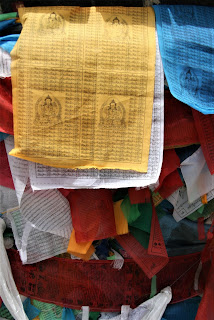





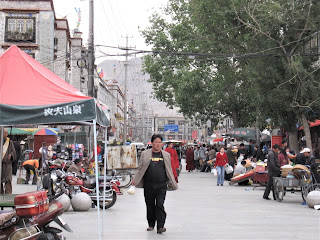





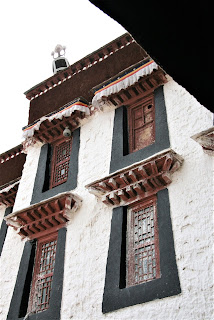




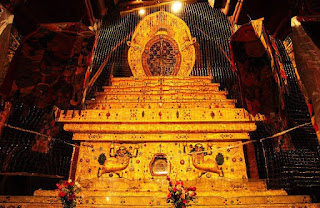
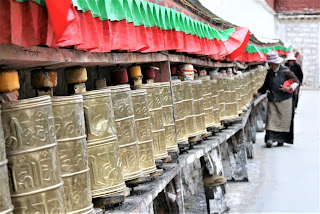

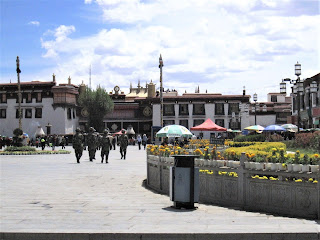
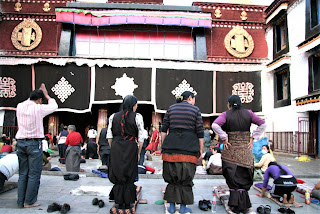

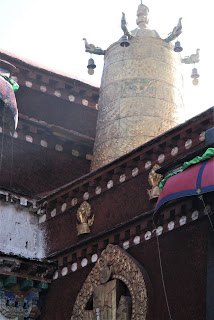














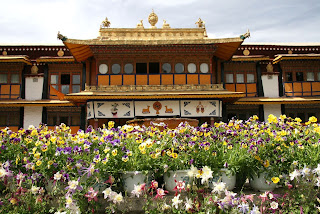
















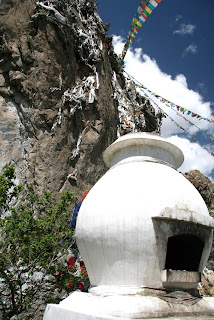



































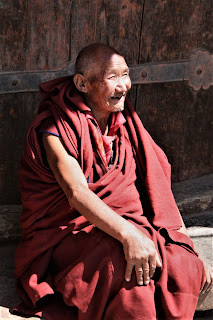
No comments:
Post a Comment